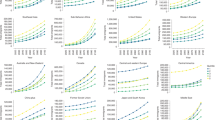Abstract
Fears of the movement of large numbers of people as a result of changes in the environment were first voiced in the 1980s (ref. 1). Nearly thirty years later the numbers likely to migrate as a result of the impacts of climate change are still, at best, guesswork2. Owing to the high prevalence of rainfed agriculture, many livelihoods in sub-Saharan African drylands are particularly vulnerable to changes in climate. One commonly adopted response strategy used by populations to deal with the resulting livelihood stress is migration. Here, we use an agent-based model developed around the theory of planned behaviour to explore how climate and demographic change, defined by the ENSEMBLES project3 and the United Nations Statistics Division of the Department of Economic and Social Affairs4, combine to influence migration within and from Burkina Faso. The emergent migration patterns modelled support framing the nexus of climate change and migration as a complex adaptive system5. Using this conceptual framework, we show that the extent of climate-change-related migration is likely to be highly nonlinear and the extent of this nonlinearity is dependent on population growth; therefore supporting migration policy interventions based on both demographic and climate change adaptation.
This is a preview of subscription content, access via your institution
Access options
Subscribe to this journal
Receive 12 print issues and online access
$209.00 per year
only $17.42 per issue
Buy this article
- Purchase on Springer Link
- Instant access to full article PDF
Prices may be subject to local taxes which are calculated during checkout



Similar content being viewed by others
References
El Hinnawi, E. Environmental Refugees (United Nations Environment Programme, 1985).
Boko, M. et al. in IPCC Climate Change 2007: Impacts, Adaptation and Vulnerability. (eds Parry, M. L., Canziani, O. F., Palutikof, J. P., van der Linden, P. J. & Hanson, C. E.) 433–467 (Cambridge Univ. Press, 2007).
van der Linden, P. & Mitchell, J.F.B. (eds) ENSEMBLES: Climate Change and its Impacts: Summary of Research and Results from the ENSEMBLES Project (Met Office Hadley Centre, 2009).
United Nations, Department of Economic and Social Affairs, Population Division World Population Prospects: The 2010 Revision (2011).
Rammel, C., Stagl, S. & Wilfing, H. Managing complex adaptive systems—A co-evolutionary perspective on natural resource management. Ecol. Econ. 63, 9–21 (2007).
Castles, S. Environmental Change and Forced Migration: Making Sense of the Debate (Evaluation and Policy Analysis Unit, United Nations High Comissioner for Refugees, 2002).
Piguet, E. Linking climate change, environmental degradation, and migration: A methodological overview. Climate Change 1, 517–524 (2010).
Jonsson, G. The Environmental Factor in Migration Dynamics—A Review of African Case Studies. Working Paper 21 (Univ. Oxford International Migration Institute, 2010).
Black, R. et al. Climate change: Migration as adaptation. Nature 478, 477–479 (2011).
Black, R., Kniveton, D. & Schmidt-Verkerk, K. Migration and climate change: Towards an integrated assessment of sensitivity. Environ. Plann. A 43, 431–450 (2011).
Massey, D. et al. Worlds in Motion: Understanding International Migration at the End of the Millenium (Oxford Univ. Press, 1998).
Konseiga, A. Household migration decisions as survival strategy: The case of Burkina Faso. J. Afr. Econ. 16, 198–233 (2006).
Thomas, D. S. G. Arid Zone Geomorphology 3rd edn (Wiley-Blackwell, 2011).
Cordell, D. D., Gregory, J. W. & Piché, V. Hoe and Wage: A Social History of a Circular Migration System in West Africa (Westview, 1996).
Jager, W. et al. Behaviour in commons dilemmas: Homo economicus and Homo psychologicus in an ecological-economic model. Ecol. Econ. 35, 357–379 (2000).
Todaro, M. P. A model of labor migration and urban unemployment in less developed countries. Am. Econ. Rev. 59, 138–148 (1969).
Harris, J. R. & Todaro, M. P. Migration, unemployment and development: A two-sector analysis. Am. Econ. Rev. 60, 126–142 (1970).
Silveira, J. J., Espindola, A. L. & Penna, T. J. P. Agent-based model to rural-urban migration analysis. Physica A 364, 445–456 (2006).
Tacoli, C. Crisis or adaptation? Migration and climate change in a context of high mobility. Environ. Urban. 21, 513–525 (2009).
Ajzen, I. The theory of planned behavior. Organ. Behav. Human Dec. Proces. 50, 179–211 (1991).
Poirier, J. & Dabiré, B. Projet d’étude des strategies de reproduction des populations sahéliennes á partir de l’enquête ‘Dynamique migratoire, insertion urbaine et environnement au Burkina Faso’. Cahiers Québécois de Démographie 30, 289–309 (2001).
Henry, S., Schoumaker, B. & Beauchemin, C. The impact of rainfall on the first out-migration: A multi-level event-History analysis on Burkina Faso. Popul. Environ. 25, 423–460 (2004).
Stark, O. & Bloom, D. E The new economics of labour migration. Am. Econ. Rev. 75, 173–178 (1985).
Watts, D. J. & Strogatz, S. H. Collective dynamics of ‘small-world’ networks. Nature 393, 440–442 (1998).
Acknowledgements
We thank B. Schoumaker for sharing the EMIUB database and C. Caminade for providing the ENSEMBLES data. This work was supported in part by an ESRC/NERC Interdisciplinary Studentship.
Author information
Authors and Affiliations
Contributions
All authors contributed extensively to the conception of the ABM and the analysis of the results. C.D.S. built and tested the ABM and D.R.K. wrote the bulk of the paper.
Corresponding author
Ethics declarations
Competing interests
The authors declare no competing financial interests.
Supplementary information
Rights and permissions
About this article
Cite this article
Kniveton, D., Smith, C. & Black, R. Emerging migration flows in a changing climate in dryland Africa. Nature Clim Change 2, 444–447 (2012). https://doi.org/10.1038/nclimate1447
Received:
Accepted:
Published:
Issue Date:
DOI: https://doi.org/10.1038/nclimate1447
This article is cited by
-
Exploring spatial feedbacks between adaptation policies and internal migration patterns due to sea-level rise
Nature Communications (2023)
-
Dry growing seasons predicted Central American migration to the US from 2012 to 2018
Scientific Reports (2023)
-
Climate migration in Asia
Letters in Spatial and Resource Sciences (2023)
-
Sub-Saharan Africa’s international migration constrains its sustainable development under climate change
Sustainability Science (2022)
-
A social network analysis of internally displaced communities in northeast Nigeria: potential conflicts with host communities in the Lake Chad region
GeoJournal (2022)


